The Best Flagship Phones of 2017, Compared
Now that we've seen the big flagship phone releases for 2017, it's time to pit the iPhone X, Galaxy S8+ and Note 8, LG V30, and Google Pixel 2 XL against one another.
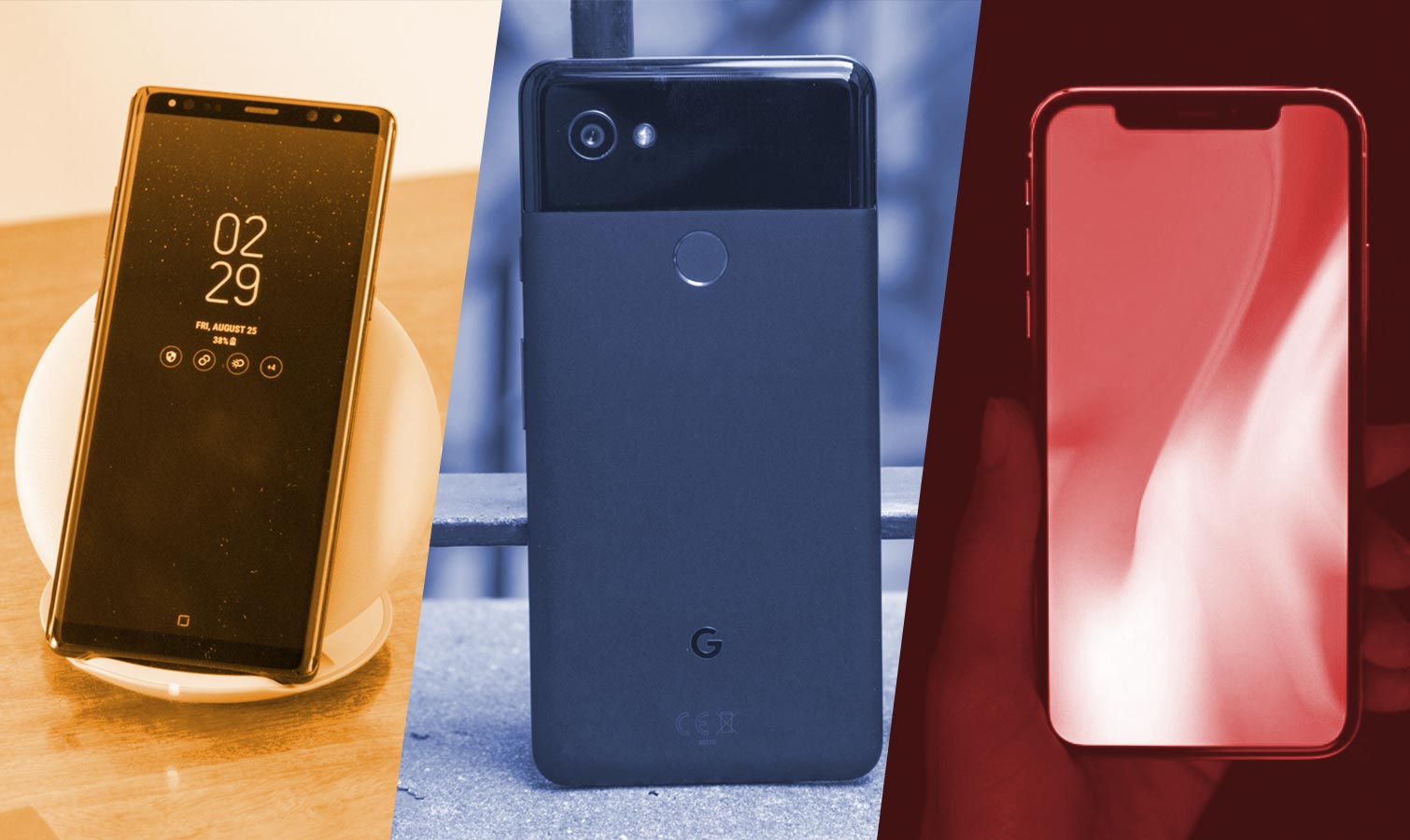
Editors' Note:This article was originally published on October 28. We've updated it with test results from the iPhone X now that we've had more hands-on time with Apple's phone.
It's a great time to buy a smartphone. All the major phone makers have rolled out their latest flagships, and a new model — the highly anticipated iPhone X from Apple — has just joined the mix. All of these phones tout cutting-edge features and introduce new designs that rely on expansive displays.
It's also quite an expensive time for smartphones, with prices climbing ever upward. The new big-screen flagships from Apple, Google, LG and Samsung all cost at least $800, with some models even approaching the $1,000 threshold.
Which of these premium handsets is most deserving of your money? To find out, we took five models that cost $800 or more — Apple's iPhone X, Google's Pixel 2 XL, the LG V30, and the Galaxy S8+ and Galaxy Note 8 from Samsung — and compared them across a variety of categories. It's a close competition, but Samsung's devices enjoy the slightest of edges as the flagship phones you want to buy.
Flagship Phone Specs
| iPhone X | Pixel 2 XL | LG V30 | Galaxy S8+ | Galaxy Note 8 | |
| Manufacturer's Price | $999 | $849 | $800 | $825 | $950 |
| OS | iOS 11 | Android 8.0 | Android 7.1.2 | Android 7.0 | Android 7.1.1 |
| Size | 5.65 x 2.8 x 0.3 inches | 6.2 x 3 x 0.3 inches | 5.97 x 2.97 x 0.29 inches | 6.3 x 2.9 x 0.3 inches | 6.4 x 2.9 x 0.34 inches |
| Weight | 6.14 ounces | 6.2 ounces | 5.75 ounces | 6.1 ounces | 6.9 ounces |
| Screen Size (Resolution) | 5.8 inches (2436 x 1125) | 6 inches (2880 x 1440) | 6 inches (2880 x 1440) | 6.2 inches (2960 x 1440) | 6.3 inches (2960 x 1440) |
| CPU | A11 Bionic | Snapdragon 835 | Snapdragon 835 | Snapdragon 835 | Snapdragon 835 |
| RAM | 3GB (estimates) | 4GB | 4GB | 4GB | 6GB |
| Storage | 64BG, 256GB | 64BG, 128GB | 64GB | 64GB | 64GB |
| microSD? | No | No | Yes | Yes | Yes |
| Water Resistance | IP67 | IP67 | IP68 | IP68 | IP68 |
| Rear Camera | Two 12-MP cameras (wide-angle: f/1.8; telephoto: f/2.4) | 12 MP (f/1.8) | 16 MP (f/1.6); 13 MP (f/1.9) | 12 MP (f/1.7) | Two 12-MP cameras (wide-angle: f/1.7; telephoto: f/2.4) |
| Front Camera | 7 MP (f/2.2) | 8 MP (f/2.4) | 5 MP (f/2.2) | 8 MP (f/1.7) | 8 MP (f/1.7) |
| Headphone Jack | No | No | Yes | Yes | Yes |
| Battery Life | 10:49 | 12:09 | 6:30 | 11:04 | 11:11 |
Design
Smartphone makers have spoken, and bezels are out. All five of these flagship phones feature minimal bezels, though in the case of the Pixel 2XL, they're still pretty noticeable. The other four phones offer edge-to-edge displays, with the iPhone X including a noticeable notch that dips down into the screen to accommodate the front-facing camera.
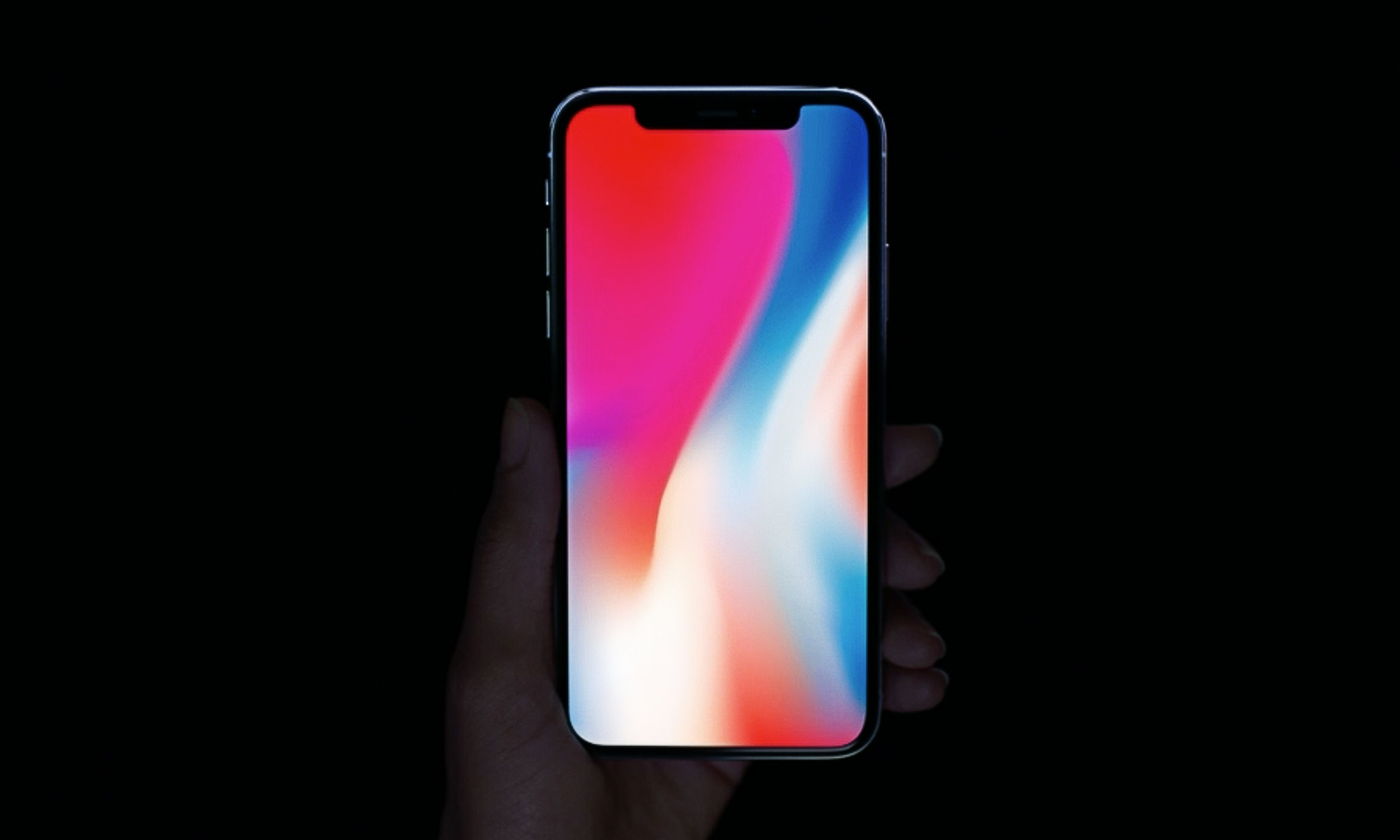
That notch also houses the sensors the iPhone X needs to support its Face ID unlocking feature. As a result, Apple's phone is the only one of these flagships to lack a fingerprint sensor. Other phone makers moved their fingerprint readers to the back of the phones, with Google and LG putting them in easy-to-find locations. Samsung placed its fingerprint sensor next to the cameras on the S8+ and Note 8, and that's probably the biggest flaw on either phone.
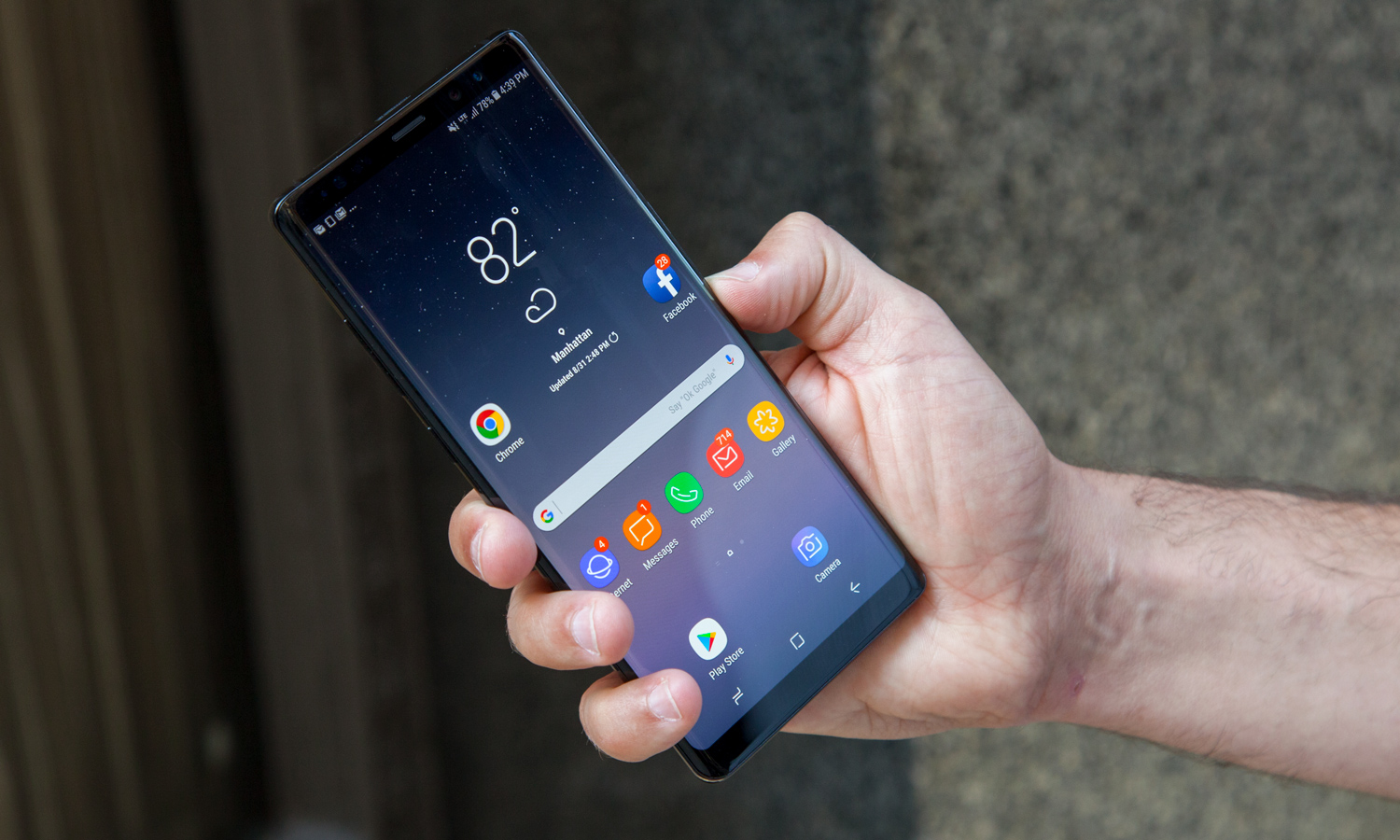
Yet, the nod here still goes to Samsung's phones, thanks to that gorgeous Infinity Display. The S8+ and Note 8 give you a futuristic look, with a good screen-to-body ratio. We're particularly impressed with the way the edges of the Note 8's screen curve around the side of the phone.
Sign up to get the BEST of Tom's Guide direct to your inbox.
Get instant access to breaking news, the hottest reviews, great deals and helpful tips.
Our Pick: Galaxy S8+ and Note 8 (tie)
Display
With Apple at last switching from the LCD panels it used in past iPhones to an OLED screen with the iPhone X, we finally have something of a level playing field for displays. But not all OLEDs are created equal, as it turns out.
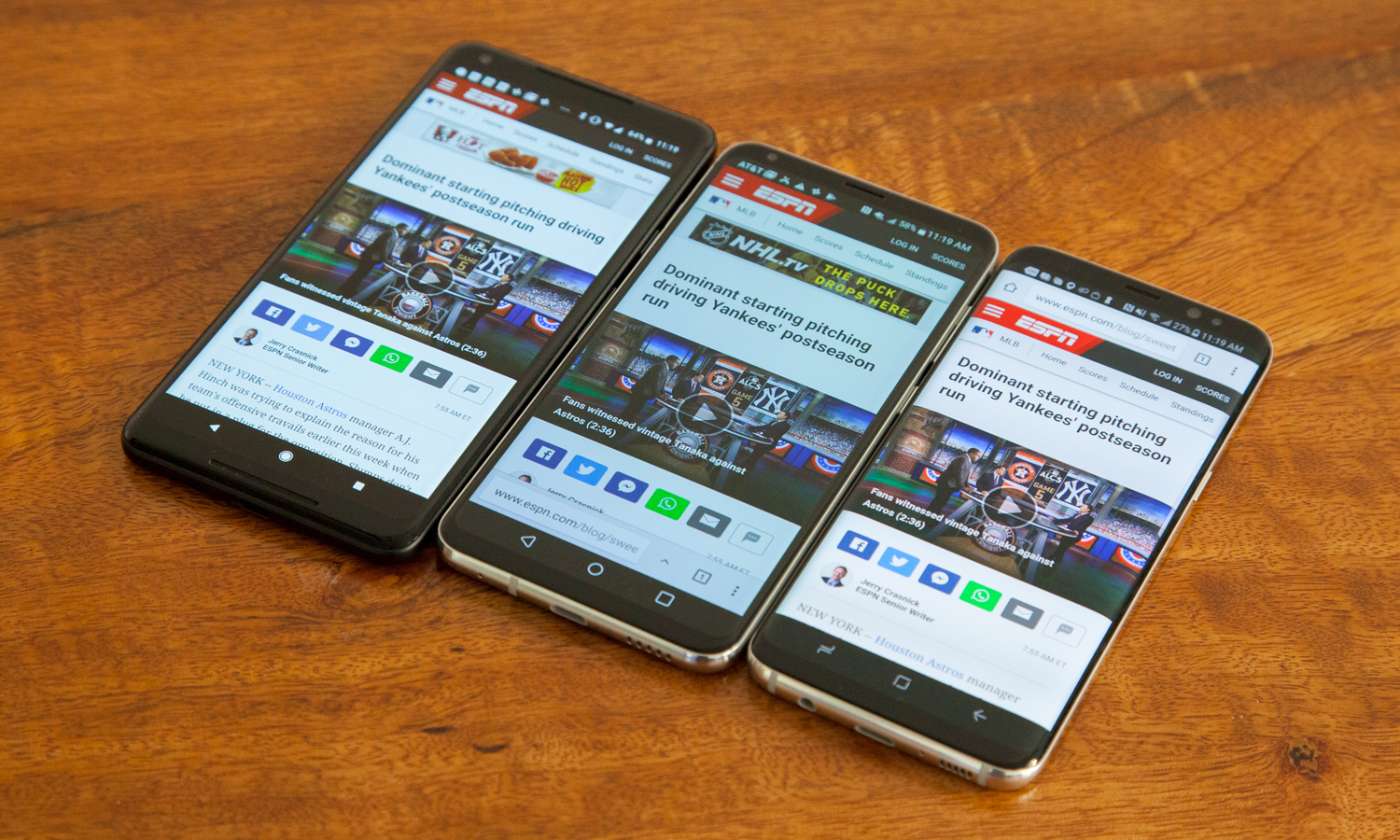
The OLED panels used for the LG V30 and Pixel 2 XL are essentially the same POLED screen. (That's no shock; LG built the Pixel 2 XL at Google's direction.) There's a bit of a tint when you look at the V30's screen at an angle. But colors are really off on the Pixel 2 XL, which suffers from color shifting as you turn the phone from side to side. There are also reports of screen burn-in. Google has promised software updates that will address both concerns about the Pixel 2 XL’s display.
Having now spent more time with the iPhone X, we like what we see in the phone's OLED display. While its 2436 x 1125 resolution can't quite match the 2960 x 1440 resolution that the Galaxy S8+ and Note 8 provide, the iPhone X is brighter than either of Samsung's phones. Using a light meter, we measured the iPhone X at 574 nits to 408 nits for the Note 8.
MORE: Best Smartphones on the Market Now
More importantly, the iPhone X is less saturated than Samsung's phones, and it does a better job with white balance. We also appreciate how Apple's phone handles viewing angles — a common problem with OLEDs where the screen can take on a blue tint when you view it off-center. The iPhone X maintains brightness as you move the phone from left to right.
Our Pick: iPhone X
Camera
This is one category in which every flagship has something to offer. If you shoot a lot of video, you'll appreciate the cinematic filters LG has included in the V30, and that phone's dual-camera setup produces stellar wide-angle shots. Dual rear cameras were also a welcome addition to the Galaxy Note 8, as they allow Samsung's phablet to take striking shots in Portrait Mode, with a stylish background blur (an effect you can customize on the fly).
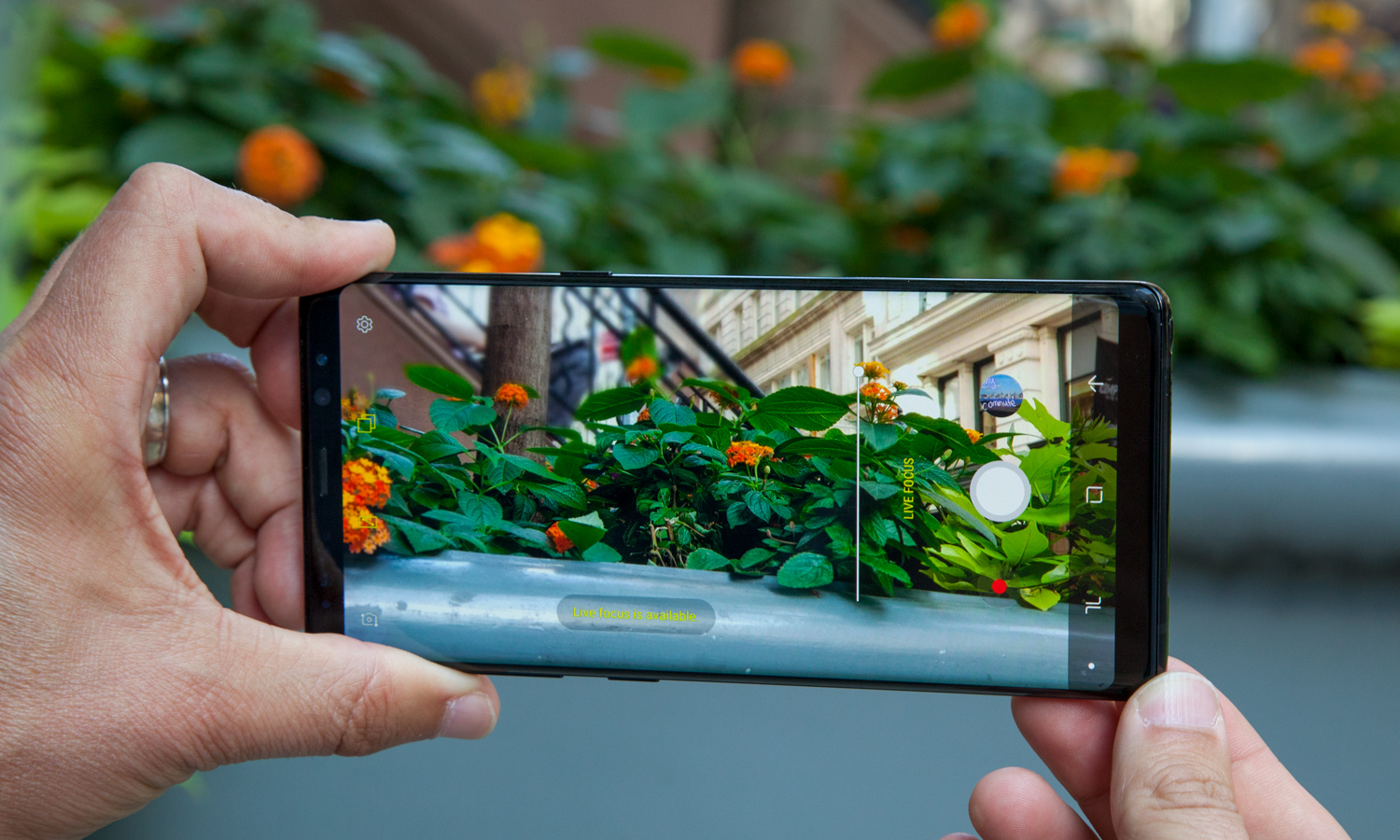
The Pixel 2 XL needs only one lens to pull off Portrait Mode, thanks to computational photography, and that phone's front-facing selfie cam offers portait shots too. And though the Galaxy S8+ offers just one rear camera, its dual-pixel technology and wide aperture produce excellent shots, even in low light.
Yet, we think the iPhone X tops them all.
MORE: These Smartphones Can Replace a Compact Camera
It's a fairly close competition, as we found when we compared Apple's new phone to the Pixel 2 XL in a head-to-head camera contest. But the iPhone X benefits from an f/2.4 aperture on its rear telephoto lens that helps it capture more detail. Both the telephoto and wide-angle lenses on the back of the iPhone offer optical image stabilization for steadier shots. And, like the Pixel 2 XL, the front camera on the iPhone X can pull off Portrait mode effects (which you can also shoot with the phone's rear cameras.)
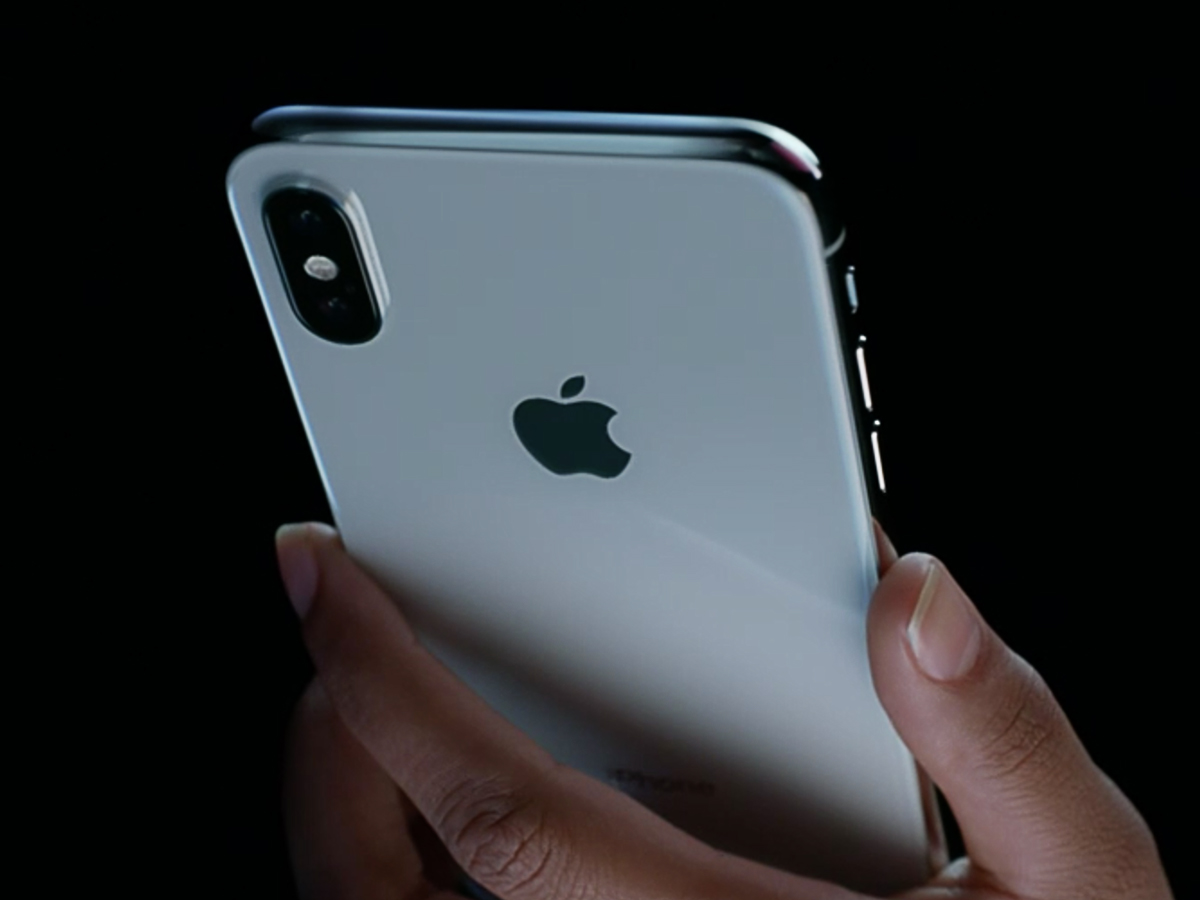
In our camera tests, the iPhone X has delivered shots with brighter colors, and it captures more details when you use the zoom. Other cameras outpace the iPhone X in low-light, but Apple's latest phone delivers quality shots under a variety of conditions.
Our Pick: iPhone X
Performance
Call it a tale of two processors. The phones from Samsung, Google and LG all feature Qualcomm's Snapdragon 835 CPU. The Note 8 has the most RAM, at 6GB; all those other Snapdragon 835-powered phones have 4GB. Not surprisingly, the Note 8 turned in the best result in the Geekbench 4 measure of overall performance, with a score of 6,564. The LG V30 fared best in the 3DMark Ice Storm Unlimited test for graphics, but the scores of all the Android phones were bunched fairly close together.
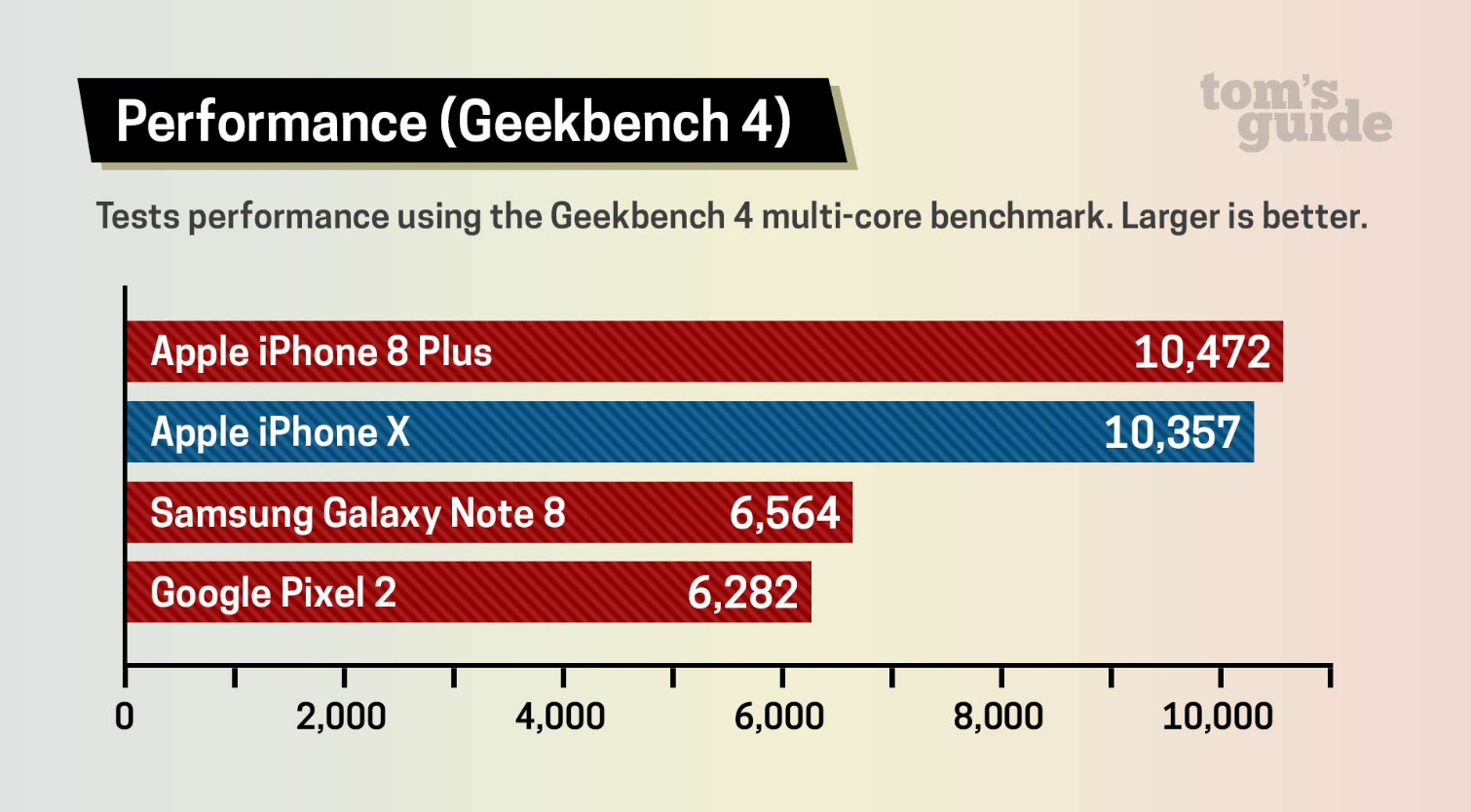
But the iPhone X, like the iPhone 8 before it, leaves those other phones in the dust, thanks to the A11 Bionic processor inside. On the Geekbench 4 test of general performance, the iPhone X scored 10,357. The top-performing Android phone on this test, the Note 8, tallied a 6,564 score. That's a pretty big edge for the iPhone.
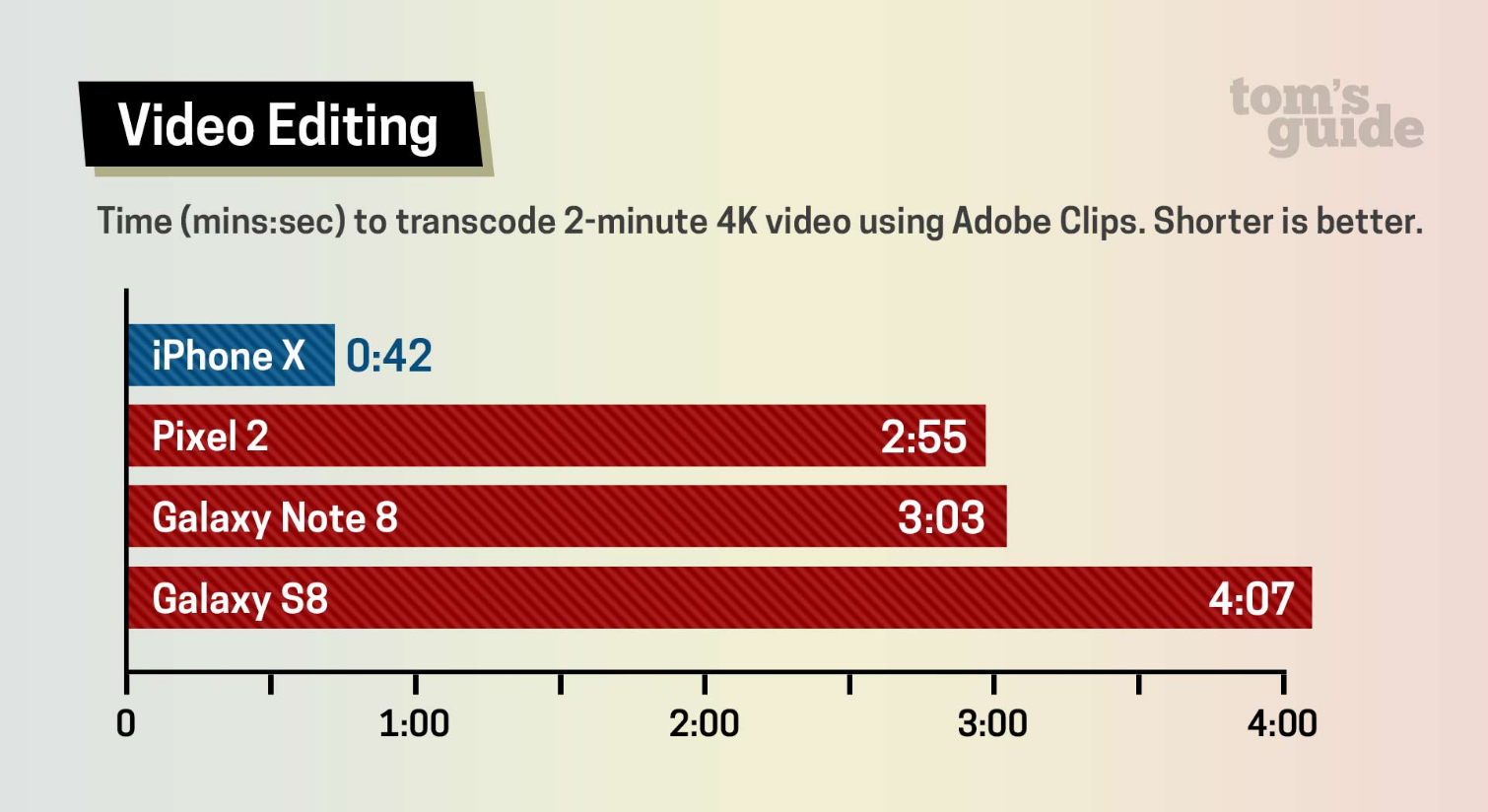
Our video-editing test, in which we transcode a 2-minute 4K video clip to 1080p in the Adobe Clips app, is especially illustrative of the A11's power. The iPhone X matched the iPhone 8's performance, pulling off that task in just 42 seconds. The fastest Android phone, the Pixel 2 XL, did the job in 2 minutes, 55 seconds.
Our Pick: iPhone X
Battery
With one glaring exception, these flagships are going to last longer on a full charge than the average smartphone. That exception: the LG V30, which died after 6 hours, 30 minutes of continuous web surfing over LTE. The average smartphone lasts 9:40 on our test. The S8+, Note 8 and Pixel 2 XL all landed on our list of longest-lasting smartphones. Google's phone had the best result, at 12:09.
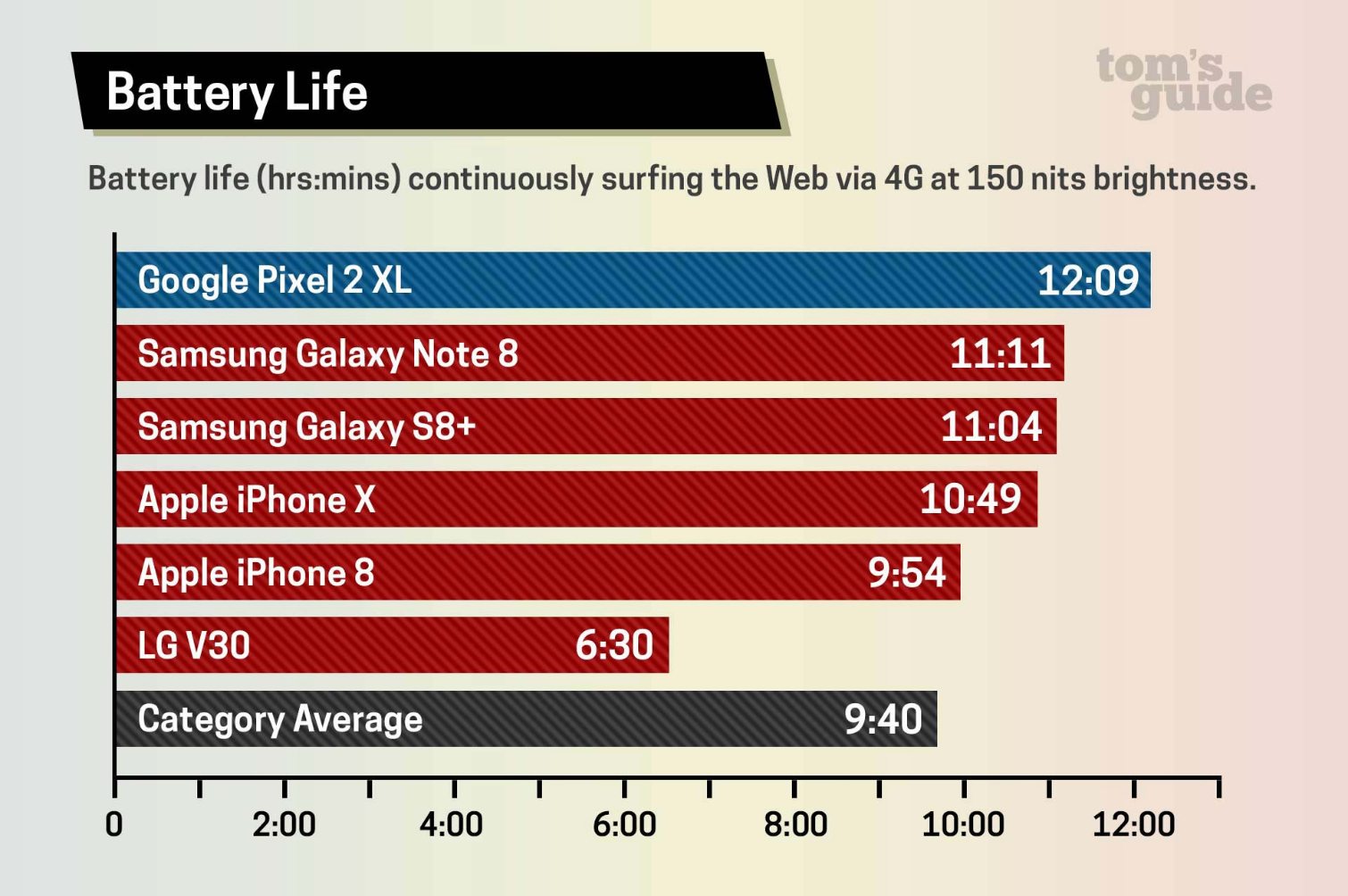
At 10:49, the iPhone X battery life is an hour better than the category average. Yet, it's not the longest-lasting smartphone Apple offers — that would be the iPhone 8 Plus, which costs $200 less than the iPhone X.
MORE: Smartphones with the Longest Battery Life
Our Pick: Pixel 2 XL
Special Features
Other than the camera, this is probably the closest competition among these five phones, and the choice of winning device really boils down to what you want out of a smartphone.
Do you create a lot of photos and videos? If so, the LG V30's Cine Video filters are appealing, and you'll love the phone's sound. The phone's 32-bit quad digital-to-analog converter produces richer audio that will have you grooving, even on an ordinary pair of earbuds.
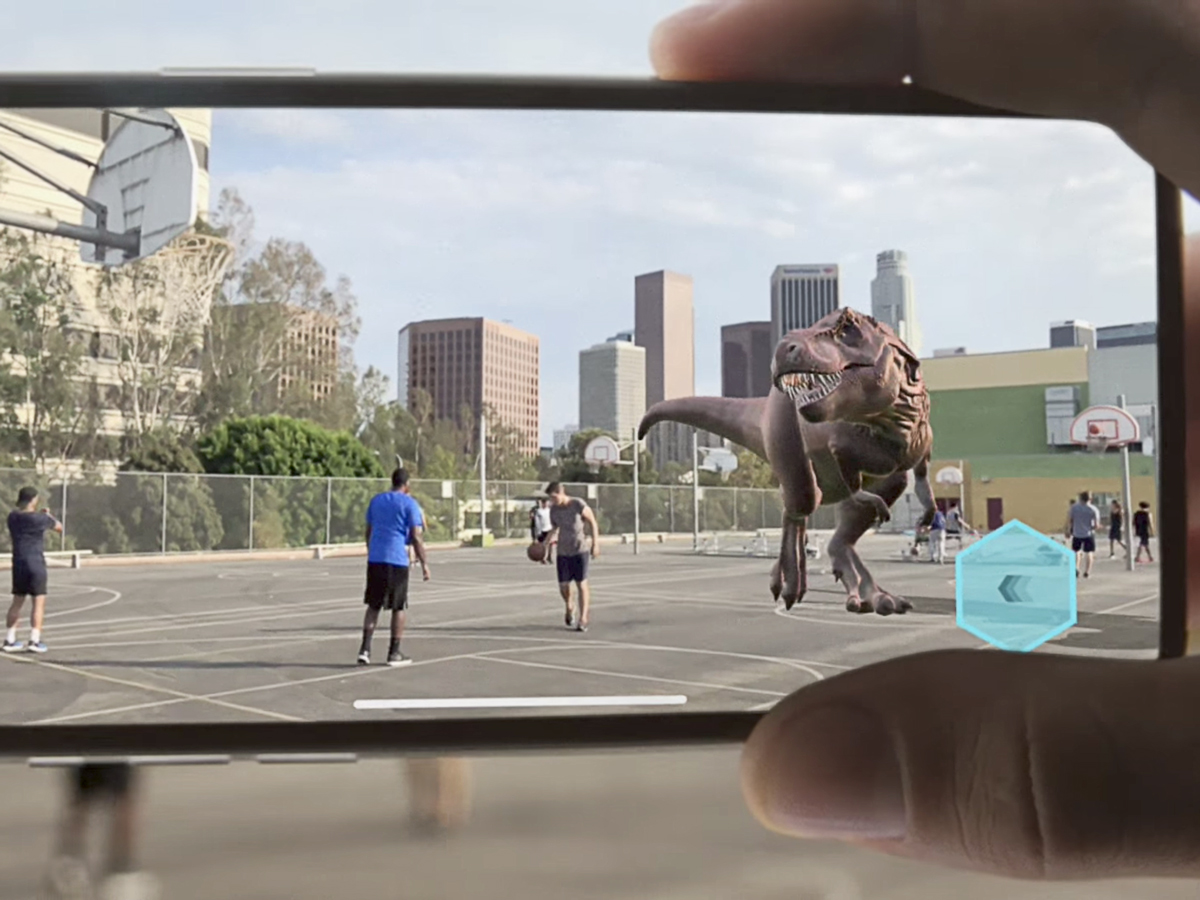
Are you ready to embrace AR? The iPhone X's cameras are specially tuned to take advantage of AR apps. Right out of the box, you'll be able to use that front-facing camera to turn your face into an animated emoji that mirrors your expression, and you can expect more third-party apps to come, thanks to Apple's ARKit. You're also able to unlock the iPhone X and confirm mobile payments with your face using the phone's Face ID feature.
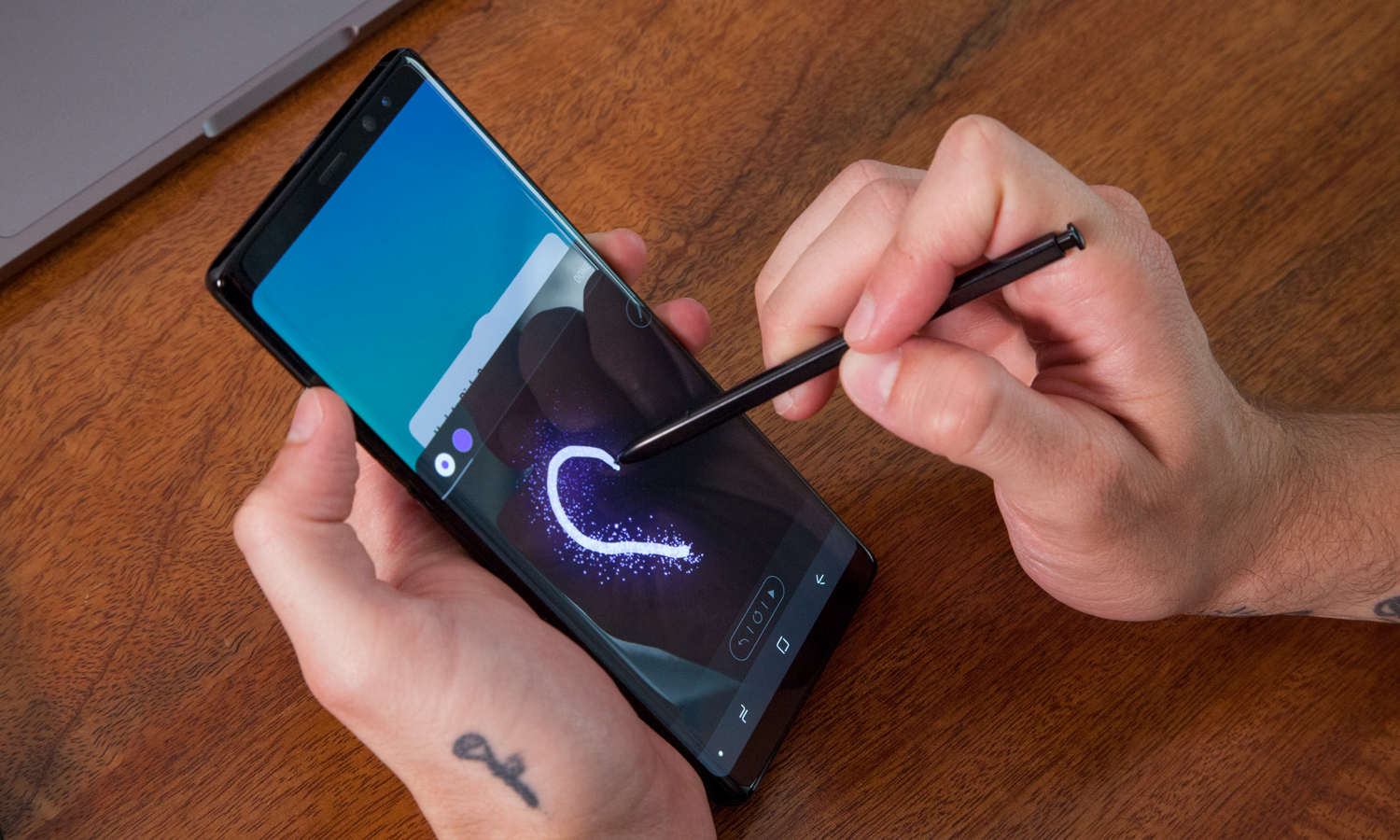
Or maybe the phone is your primary productivity tool? Then you'll really enjoy the S Pen that comes with the Note 8. Not only can it translate text or turn sketches into GIFs, but the S Pen also lets you scribble up to 100 pages of memos without ever unlocking your phone. Like the S8+, the Note 8 also works with Samsung's DeX station accessory, which lets your smartphone double as a portable PC. And both the S8+ and Note 8 include Bixby, Samsung's new and improving digital assistant.
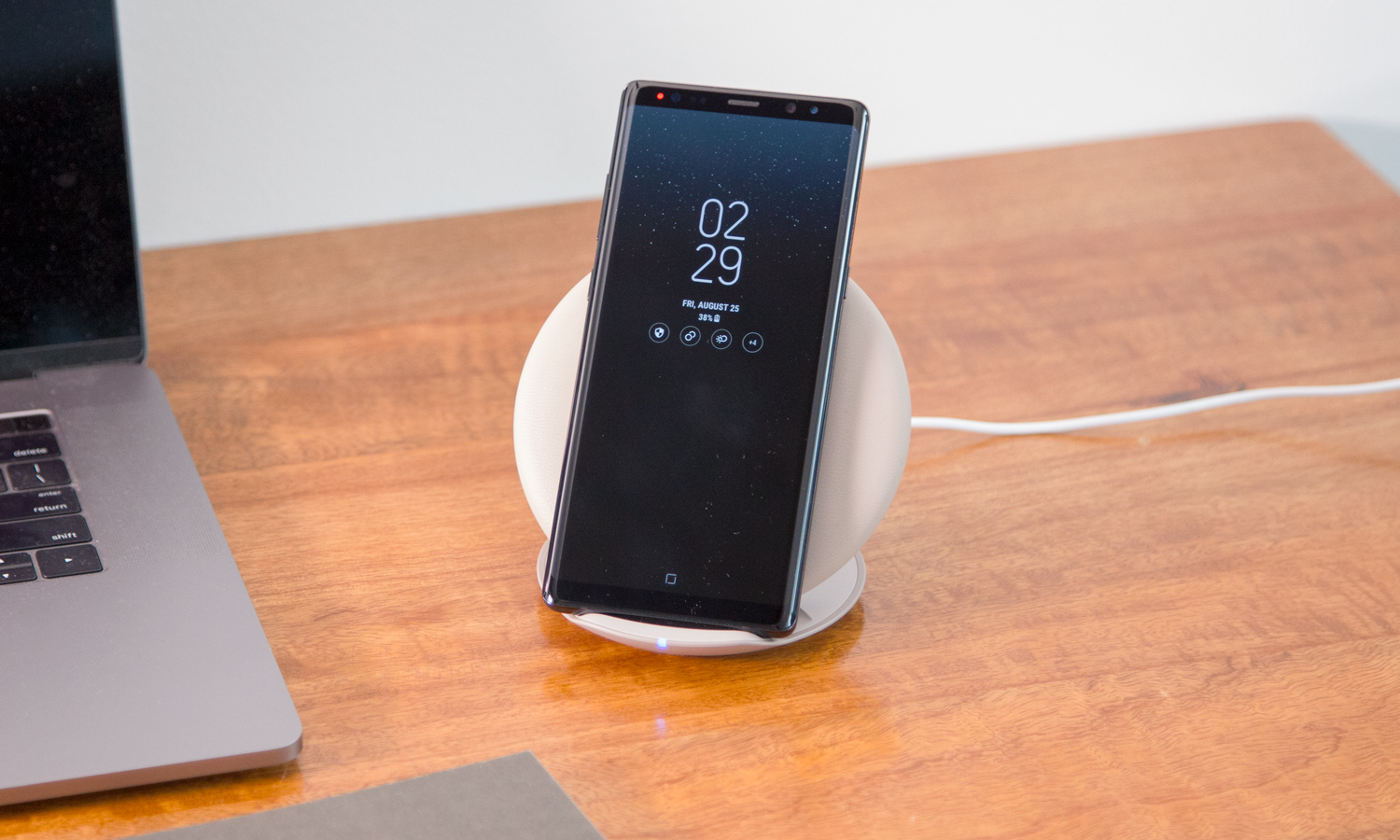
We like our smartphones to be extra smart, though, and it's hard to top what Google is doing with the Pixel 2 XL. The phone supports Google Lens, a new feature that taps into object recognition to turn your camera or your photo roll into a discovery tool. Select a picture of a famous landmark in Google Photos, and Google Lens can summon up a description about what you're looking at. Point the Pixel 2 XL's camera at a Wi-Fi password, and you can capture it, saving yourself from the tedium of data entry.
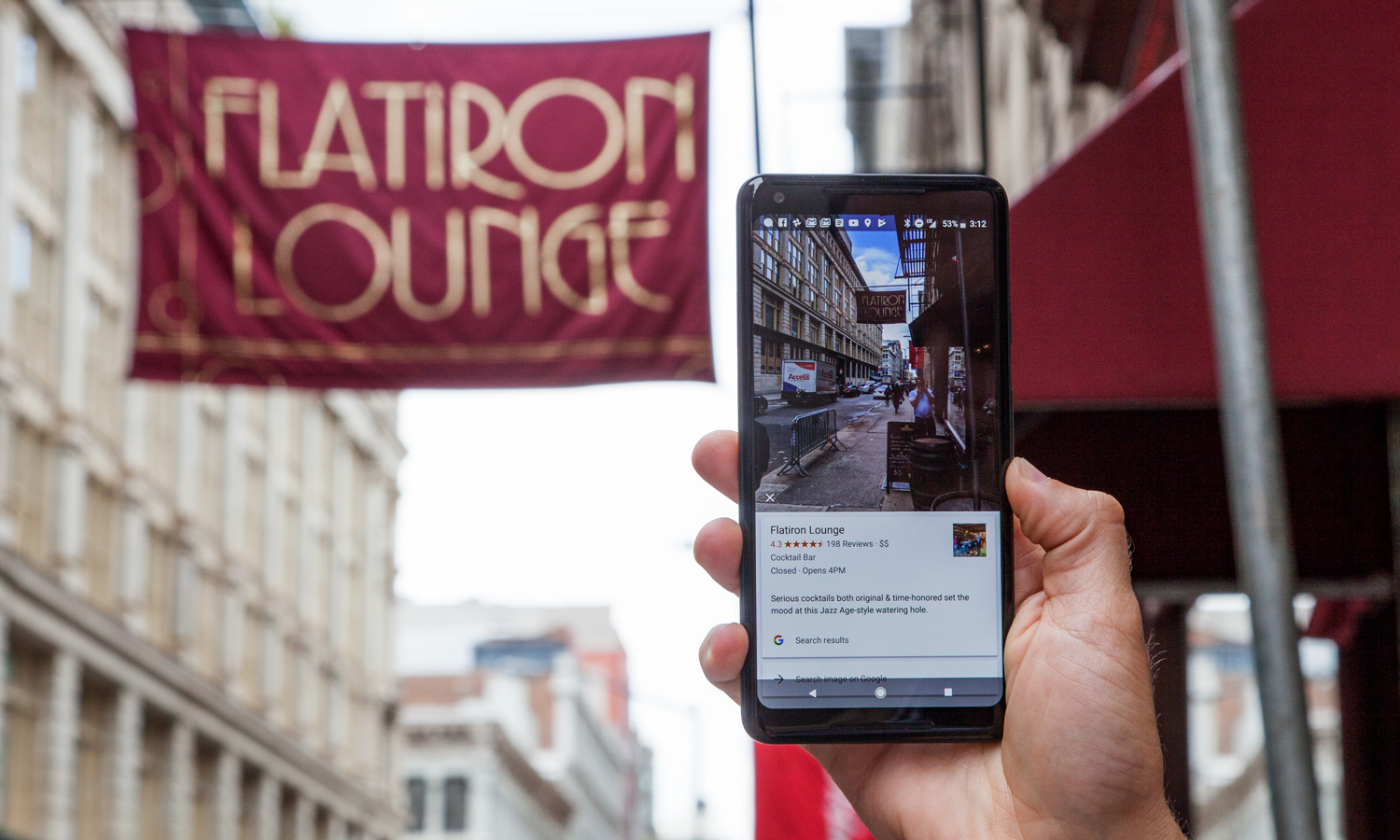
The Google Assistant is the best of the digital assistants for our money, and the Pixel 2 XL lets you summon the feature just by squeezing the sides of the phone. And since this phone comes directly from Google, you're always assured of getting security and Android updates the moment they're available.
Our Pick: Pixel 2 XL
Value
If you look only at dollars and cents, the LG V30 seemingly has a leg up here. It's the least expensive of the four flagships in this review, with a starting price of $800 if you buy the phone from T-Mobile. But at the moment, you're limited to specific carriers: LG doesn't offer an unlocked version of the V30 right now. Which carrier you choose also affects which model you get, as only Sprint offers the higher-capacity V30+.
The Galaxy S8+ offers the widest range of prices — not surprising, because that phone has been out the longest. Samsung lists the price of the S8+ at $825, but you can find it for less than $800 at some retail outlets. You can also buy the S8+ unlocked, just like you can with the pricey, $950 Note 8.
After Samsung's phones, the $849 Pixel 2 XL probably offers the greatest flexibility. While Verizon is the only carrier selling Google's new phone, you can also buy an unlocked Pixel directly from Google and use the device with whatever carrier you want. You can also use the phone with Google's Project Fi wireless service if you prefer.
The iPhone X is the priciest model in this comparison. And since the $999 phone is available only for preorder now, you'll be hard-pressed to find any iPhone X deals or discounts right now. The best you can do is money back if you have an older phone to trade in.
Winner: Galaxy S8+
Bottom Line
Add it all up, and Samsung's phones retain a slight edge, sharing top honors for design, and ranking as runner-up choices in several categories. The Galaxy S8+ gets the nod over the Note 8, because it's a little less expensive and you're more likely to find a deal on this slightly older phone.
| iPhone X | Pixel 2 XL | LG V30 | Galaxy S8+ | Galaxy Note 8 | |
| Design | 3 | 1 | 2 | 5 | 5 |
| Display | 5 | 1 | 2 | 4 | 4 |
| Camera | 5 | 3 | 1 | 4 | 2 |
| Performance | 5 | 2 | 1 | 3 | 4 |
| Battery | 2 | 5 | 1 | 3 | 4 |
| Special Features | 3 | 5 | 1 | 2 | 4 |
| Value | 1 | 3 | 4 | 5 | 2 |
| Overall | 24 | 20 | 12 | 26 | 25 |
The Pixel 2 XL did remarkably well, winning two of our face-off categories. We'd hesitate to recommend that device over Samsung's phones at this point, however, at least until Google resolves some of the display issues that have cropped up. But if you want a long-lasting phone that packs in intriguing features, Google's latest is an appealing option.
The iPhone X comes very close to supplanting the Samsung phones, and now that we've had more time with Apple's phone, we think it has the best OLED screen. It also won the performance and camera rounds, though it faces some stiff competition in that latter category. But the Samsung phones boast better endurance and lower price tags, giving them an edge over Apple's new model.
Credit: Tom's Guide
Philip Michaels is a Managing Editor at Tom's Guide. He's been covering personal technology since 1999 and was in the building when Steve Jobs showed off the iPhone for the first time. He's been evaluating smartphones since that first iPhone debuted in 2007, and he's been following phone carriers and smartphone plans since 2015. He has strong opinions about Apple, the Oakland Athletics, old movies and proper butchery techniques. Follow him at @PhilipMichaels.
-
misterioso Your battery life assessment of the LG V30 is absolutely wrong. Either you received a bad sample phone or your settings are incorrect. The majority of the web reviews and comparisons of the LG V30 against it's price point competitors (iPhone 8X, Samsung S8X/Note 8, and Pixel 2X), shows the LG V30 performing at or near the top in battery tests.Reply -
misterioso LG V30 Battery life according to...Reply
The Verge: "Impressive speed and battery life"
https://www.theverge.com/2017/10/16/16457544/lg-v30-review-design
TechRadar: "Either way, we’ve been delighted by the 3,300mAh battery in the non-final unit. Ringing in at the same size as the cell found with the Samsung Galaxy Note 8, all-day battery life is an easy goal for this phone to meet."
http://www.techradar.com/reviews/lg-v30/3
DigitalTrends: "The battery life on the V30 is impressive, as we consistently saw a day and a half from its fully charged 3,300mAh cell, even on the pre-production software, with medium to heavy use."
https://www.digitaltrends.com/cell-phone-reviews/lg-v30-review/
9to5Google: "Battery life has also been a big question surrounding the V30. A high-resolution 6-inch display combined with a 3,300 mAh battery isn’t necessarily a great formula, but on the V30 it actually holds up pretty well. Over the past few days, the phone’s battery has easily gotten me through each day, regardless of the amount of use."
https://9to5google.com/2017/09/05/lg-v30-display-battery-camera-impressions/
Phone Battles: Battery Life Test! LG V30 vs Galaxy Note 8 vs iPhone 8 Plus vs Xperia XZ Premium. LG V30 wins.
https://youtu.be/4A4m0hJz5ng
Engadget: "When it comes to day-to-day use, the V30 is pretty average. On a typical day, I'd pull the V30 off the charger at around 8 AM, take it to work, run it through my usual routine, and get a low-battery warning at around 9 PM. That's not bad -- I got similar results out of the Galaxy Note 8, and I've occasionally found the V30 still clinging to life after nights when I had forgotten to charge it."
https://www.engadget.com/2017/10/28/lg-v30-review/
ZDNet: "On this retail version, battery life has been excellent, even exceeding what I see on the larger Note 8 and other smartphones in my collection. You can get through a full, rather heavy day with the LG V30."
http://www.zdnet.com/product/lg-v30/
-
rickneworleansla I stopped reading after then part about iPhone 8 Plus / X camera being better than the Pixel 2. I've done several comparisons not knowing which camera the pictures came from. I've even given the tests to friends or relatives for comparison. Every single time it's been Pixel 2 easily in first place, the S8 in the middle, and the iPhone 8 plus dead last.Reply -
siddamshetty.sridhar you are apple fan. what ever your comparison will go in favour of apple products. Good luck with blood sucker apple phone prices and tarriffsReply -
kopara76 How does galaxy s8+ score a 4 but the note 8 a 2? The only description you gave the s8+ is the dual pixel capability which the note 8 also has in addition to OIS for both wide and telephoto lenses. In addition, dxomark rates note 8 even with the iPhone 8+ even though most sites rates note 8 better for noise reduction (OIS both lenses ) and better low light performance and dual pixels capability.Reply -
schmidke Good analysis. Makes comparison amongst these to phones easier. What is missing though for the camera is the actual lens spec. I.e. 28mm, 30mm etc. The lower the wider of course. I have generally found that the Samsung's are wider angled than the Apple. 1 or 2 mm may sound small, until you try it. Maybe you can update these tests to show this?Reply -
ianrg I agree with KOPARA76. The Camera figures for the Note 8 vs the s8+ look like they are wrong. The superior camera on the Note 8 is given a 2, whilst the inferior camera on the s8+ is given a 4. I think these are the wrong way round and this would change who comes first.Reply -
pdaguru.okhiria81 There's is an error in camera comparison here . Maybe some guess work without any actual test. Otherwise, how could you even rate iPhone 8 over note 8 let alone rating an S8 over the almighty note 8? Go and carry out some test dear.Reply

